The Method Developed by VU Biophysicists Can Help Accelerate the Diagnosis of Oncological Diseases
 Researchers from the Faculty of Physics and the Life Sciences Center of Vilnius University (VU), with co-authors from Harvard University, the University of Toronto, National Cancer Institute and "Light Conversion" developed a method which can improve the diagnostics of cancer and other diseases. A novel multidisciplinary study published in "Scientific Reports", a "Nature Publishing Group" journal, describes how to quickly and accurately analyze the structure of collagen in tissue.
Researchers from the Faculty of Physics and the Life Sciences Center of Vilnius University (VU), with co-authors from Harvard University, the University of Toronto, National Cancer Institute and "Light Conversion" developed a method which can improve the diagnostics of cancer and other diseases. A novel multidisciplinary study published in "Scientific Reports", a "Nature Publishing Group" journal, describes how to quickly and accurately analyze the structure of collagen in tissue.
Collagen is a structural protein with various functions related to cell activity. Researchers say that the method, Double Stokes polarimetry, is based on the dependence of the response of collagen to variously polarized laser light.
"Polarization measurements allow to determine the ultrastructural parameters of collagen, which describe its molecular structure. This lets to evaluate the changes in collagen structure appearing during various diseases. Similar methods have been used to investigate breast and lung cancer tissues, among other cancer types, as well as other diseases, such as keratoconus. The changes in collagen structure are related to disease progression and symptoms. The main advantage of this method is its speed, which is several hundred times greater than that of other similar methods. That’s important for its wider application in clinical settings", tells VU Life Science Center's PhD student Viktoras Mažeika.
VU Faculty of Physics' PhD student Mykolas Mačiulis claims that this research will be relevant in the future. "The work done here is fundamental, and we continue doing related research. Next, we'll apply this method to analyze cancerous samples, as well as those of other diseases. Science has to answer society's needs, and disease diagnostics are important for humanity", he adds.
"This work can significantly contribute to the development of oncological and histopathological diagnostics. We hope that this method will allow physicians to more effectively detect subtle tissue changes. Collagen is the most common protein in the human body, so investigation of its structure would allow for more accurate disease diagnostics", states Prof. Dr. Virginijus Barzda.
Biophysicists from the VU Advanced Biomedical Photonics Group are developing nonlinear microscopy methods and devices which can be applied in life sciences, medical, pharmaceutical or materials engineering research. Modern technologies of physics, chemistry and biology are successfully used in oncology.